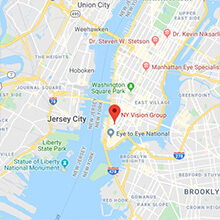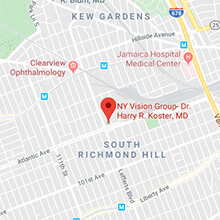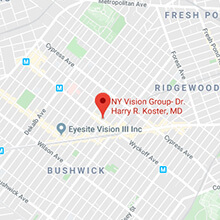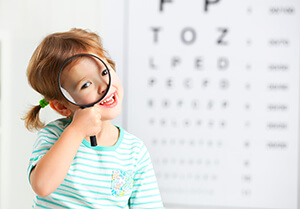 Good vision is key to a child’s physical development, success in school and overall well-being. Young children may be unaware that they are experiencing abnormal vision, which is why regular eye exams and early detection are essential in maintaining healthy eyes and normal development for a child.
Good vision is key to a child’s physical development, success in school and overall well-being. Young children may be unaware that they are experiencing abnormal vision, which is why regular eye exams and early detection are essential in maintaining healthy eyes and normal development for a child.
In babies and young children, the vision system is not fully formed and equal input from both eyes is necessary for the brain’s vision centers to develop normally. If a young child’s eyes cannot send clear images to the brain, his or her vision may become limited in ways that cannot be corrected later in life. But if problems are detected early, it is usually possible to treat them effectively. Furthermore, because clear vision and healthy eyes are important not only to your child’s overall health but also to their academic performance in school, it is important for children to have comprehensive eye exams by trained ophthalmic professionals such as the doctors at NY Vision Group. While a child’s vision may be checked at school each year, these exams may only evaluate eyesight and not test the overall health of the eyes.
Safety Precautions Parents Should Take For Sports
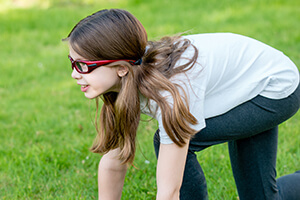 Playing sports such as baseball is a part of a healthy lifestyle. Given the high levels of obesity in the United States, children’s participation in sports should be thoroughly encouraged. However, tens of thousands of sports and recreation-related eye injuries occur each year. According to the AAO, about 30,000 people in the US go to emergency departments each year with sports-related eye injuries. The good news is that 90% of serious eye injuries are preventable through the use of appropriate protective eyewear.
Playing sports such as baseball is a part of a healthy lifestyle. Given the high levels of obesity in the United States, children’s participation in sports should be thoroughly encouraged. However, tens of thousands of sports and recreation-related eye injuries occur each year. According to the AAO, about 30,000 people in the US go to emergency departments each year with sports-related eye injuries. The good news is that 90% of serious eye injuries are preventable through the use of appropriate protective eyewear.
For all age groups, sports-related eye injuries occur most frequently in baseball, basketball and racquet sports. However, for children and young adult athletes between the age of 5 and 15, most sports-related injuries in the US occur while playing baseball. Consequently, Dr. Harry Koster recommends wearing sports eye protectors for basketball, football, racquet sports, indoor soccer, hockey, lacrosse and especially baseball.
“Both of my children play little league baseball and once they made the transition to playing with a hardball (after the wiffle ball of the early years), I recommended that they wear protective eyewear,” says Dr. Koster, “I’ve seen too many eye injuries to young players. And for my son who also pitches, protective eyewear is a must.” Dr. Koster recommends choosing eye protectors with polycarbonate (an especially strong, shatterproof lightweight plastic) that has either been tested to meet the American Society of Testing and Materials standards or that passes the CSA racquet sports standards. And of course, batting helmets should be worn by any player at-bat.
If a child already has reduced vision in one eye, parents should consider the risks of injuring the stronger eye before allowing the child to participate in baseball or other contact or racquet sports. Check with the doctors at NY Vision Group to see if additional eye protection is warranted and whether participating in such a sport is advisable.
If a child’s eye is injured, see a health care professional, preferably an ophthalmologist, or go to the emergency room immediately even if the eye injury appears minor. Delaying medical attention can result in permanent vision loss or blindness.
While seeking medical help, care for the child as follows:
- DO NOT touch, rub or apply pressure to the eye.
- DO NOT try to remove any objects stuck in the eye. For small debris, lift the eyelid and ask the child to blink rapidly to see if tears will flush it out. If not, close the eye and seek treatment.
- DO NOT apply ointment or medication to the eye, unless you are a trained eye professional.
- A cut or puncture wound should be gently covered.
- Only in the event of chemical exposure, flush eye with water or saline solution.
With the proper protective equipment, playing baseball and engaging in other sports are wonderful, healthy lifestyle choices for children and adults alike.
*Statistics courtesy of the American Academy of Ophthalmology.
When Should Your Child See a Pediatric Ophthalmologist?
The American Academy of Ophthalmology and the American Association for Pediatric Ophthalmology and Strabismus recommend that a child’s eyes should be examined on the following schedule:
Newborn: An ophthalmologist, pediatrician, family doctor or other trained health professionals should examine a newborn baby’s eyes and perform a red reflex test (a basic indicator that the eyes are normal). A trained eye professional should perform a comprehensive exam if the baby is premature or at high risk for medical problems for other reasons, has signs of abnormalities, or has a family history of serious vision disorders in childhood.
Infant: Infants should have second screening between six months and the first birthday (this can be part of the child’s well-care visit)
Preschooler: Between the ages of 3 and 3½, a child’s vision and eye alignment should be assessed again by a pediatrician, family doctor, ophthalmologist, optometrist or person trained in vision assessment of preschool children. If refractive errors or alignment problems (such as misaligned eyes (strabismus), “lazy eye” (amblyopia) is suspected, a more comprehensive exam should be performed so that any necessary treatment begins as soon as possible.
School-Age and Older: Upon entering school or whenever a problem is suspected, children’s eyes should be checked again for visual acuity and alignment issues. In addition, it is a good idea to add eye exams to your “back to school” to-do lists for your children. Not only are children sometimes unaware of any vision problems they have, they often will not complain, making regular screenings even more important. According to the American Academy of Ophthalmology, one study showed that one-third of US children age 12-17 are nearsighted, yet almost 40% of US children have never had a vision screening. Help your child succeed in the classroom by making sure any vision problems are identified and corrected before they affect your child’s education
At NY Vision Group we can test visual acuity and assess eye alignment for children who are old enough to generally cooperate with an eye exam (typically age 4 or 5), although we will see any child in the case of an eye emergency. We can test visual acuity with either a standard eye chart or the Nidek autorefractor. The Nidek autorefractor gives us a highly accurate reading of the child’s refraction and does not require a young child to decipher symbols on a chart. Either approach to testing will determine whether the child can focus normally at far, middle and near distances and if the child has any refractive errors such as myopia (nearsightedness), hyperopia (farsightedness) or astigmatism).
Nearsightedness is the most common refractive error at this age and can be corrected with eyeglasses. Other refractive errors are also common and it is possible for a child to have more than one type of refraction issue. At NY Vision Group we also provide a comprehensive exam for misaligned eyes (strabismus), “lazy eye” (amblyopia), and other focusing problems. If any of these conditions is suspected, we will recommend various treatment options.
For older children (teenagers and above), eye exams are very similar to those used for adults, including a visual field test, dilation, slit lamp examination, retinoscopy, and refraction. After the exam is completed and an accurate diagnosis has been made, we will develop a treatment plan that may include eyeglasses, prescription, medication, or surgery if any conditions do exist. LASIK is not typically performed on children: patients must typically be at least 18 with stable eye prescriptions.
Common Eye Conditions Treated by Pediatric Ophthalmologists
Common childhood eye conditions include lazy eye (amblyopia) and crossed eyes (strabismus). These conditions are often a result of genetic factors and should be treated early to reduce the risk of complications.
Amblyopia (Lazy Eye)
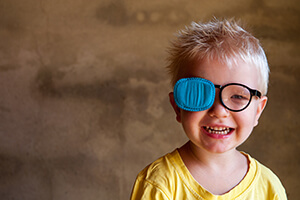 Amblyopia occurs when one eye develops good vision while the other does not. The eye with the poorer vision is called amblyopic. This condition is quite common; approximately two to three out of every 100 people have it. Usually, only one eye is amblyopic but it possible for both eyes to be “lazy”. The best time to correct amblyopia is during infancy or early childhood. During early childhood years, children’s visual systems change quickly and their sight continues to develop. In order for a child to have normal vision, it is important that both eyes develop an equal vision. After the first nine years of life, the visual system is normally fully developed (and is difficult to change). Therefore if amblyopia treatment is not begun as early as possible, several problems can develop that can seriously affect vision from childhood into adulthood. These problems include that: the amblyopic eye may develop a serious and permanent visual defect; depth perception (seeing in three dimensions) may be lost because good vision in both eyes is needed; if the stronger eye becomes diseased or injured, it can mean a lifetime of poor vision.
Amblyopia occurs when one eye develops good vision while the other does not. The eye with the poorer vision is called amblyopic. This condition is quite common; approximately two to three out of every 100 people have it. Usually, only one eye is amblyopic but it possible for both eyes to be “lazy”. The best time to correct amblyopia is during infancy or early childhood. During early childhood years, children’s visual systems change quickly and their sight continues to develop. In order for a child to have normal vision, it is important that both eyes develop an equal vision. After the first nine years of life, the visual system is normally fully developed (and is difficult to change). Therefore if amblyopia treatment is not begun as early as possible, several problems can develop that can seriously affect vision from childhood into adulthood. These problems include that: the amblyopic eye may develop a serious and permanent visual defect; depth perception (seeing in three dimensions) may be lost because good vision in both eyes is needed; if the stronger eye becomes diseased or injured, it can mean a lifetime of poor vision.
People with amblyopia in one eye are more than twice as likely to lose vision in the healthy eye from trauma. If the vision in one eye should be lost later in life from an accident or illness, it is essential that the other eye have normal vision. Another important reason to make sure amblyopia is detected and treated as early as possible in childhood is that people who have good vision in only one eye may find they are limited in the kinds of jobs they can perform.
Symptoms of Amblyopia
Some symptoms of amblyopia (lazy eye) to look for in a child include:
- Poor vision in one eye or overall poor vision
- Squinting, tilting the head or closing one eye to see
- Poor depth perception (difficulty judging relative distances between objects)
- An inward- or outward-wandering eye
- Headaches
If a parent notices these symptoms in their child, it is very important that the child is examined by an ophthalmologist. Lazy eye correction or treatment should begin as soon as possible so that the child’s visual system can develop properly.
Strabismus (Crossed Eyes)
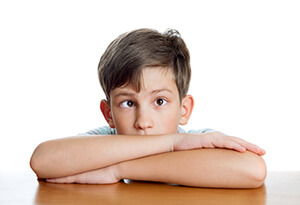 Strabismus is a visual problem in which the eyes are not aligned properly and point in different directions. One eye may look straight ahead, while the other eye turns inward, outward, upward, or downward. The eye turn may be consistent, or it may come and go. Which eye is straight (and which is misaligned) may switch or alternate. Strabismus is a common condition among children. About 4% of all children in the United States have strabismus. It can also occur later in life and may run in families, although many people who have strabismus have no relatives with this problem.
Strabismus is a visual problem in which the eyes are not aligned properly and point in different directions. One eye may look straight ahead, while the other eye turns inward, outward, upward, or downward. The eye turn may be consistent, or it may come and go. Which eye is straight (and which is misaligned) may switch or alternate. Strabismus is a common condition among children. About 4% of all children in the United States have strabismus. It can also occur later in life and may run in families, although many people who have strabismus have no relatives with this problem.
Treatment for strabismus works to straighten the eyes and restore binocular (two-eyed) vision. In some cases of strabismus, eyeglasses can be prescribed for your child to straighten the eyes. Other treatments may involve surgery to correct the unbalanced eye muscles or to remove a cataract. Patching or blurring the strong eye to improve amblyopia is often necessary.
Symptoms: The main sign of strabismus is an eye that is not straight. Sometimes children will squint one eye in bright sunlight or tilt their head to use their eyes together. If a parent suspects their child has strabismus, they should consult an eye care professional.
Pseudostrabismus
This is a condition in which the eyes of infants often appear to be crossed, though actually, they are not. This condition is called pseudostrabismus. Young children often have a wide, flat nose and a fold of skin at the inner eyelid that can make eyes appear crossed. This appearance of pseudostrabismus may improve as the child grows. A child will not outgrow true strabismus. An ophthalmologist can distinguish true strabismus and pseudostrabismus.
Common Eye Diseases
If the following diseases are suspected, the child should be seen by an eye care professional such as the doctors at NY Vision Group.
Conjunctivitis
Conjunctivitis (pink eye) can refer to either a viral or bacterial infection (both very contagious) or an allergic reaction (not contagious).
The symptoms of conjunctivitis include:
- The eye tears have discharge or both and are usually itchy and uncomfortable.
- When a viral infection is a cause, the child may also have a fever, sore throat, and runny nose.
- The eye appears red or pink due to inflammation of the conjunctiva (the thin, filmy membrane that covers the inside of the eyelids and white part of the eye).
If the child has (or may have) a contagious pink eye, he or she needs to stay home from school or return home to avoid infecting others. Contagious pink eye usually resolves in three to seven days. When the tearing and discharge from the eyes have stopped, the child may return to school.
Chalazion
Chalazion looks like a small lump on the eyelid and may occur when a meibomian gland (an oil-secreting gland in the eyelid) becomes clogged. It is not caused by infection.
Stye
A stye looks like a red, sore lump near the edge of the eyelid; it is caused by an infected eyelash follicle.
Chalazion and styes can be treated similarly in the following manner:
- Warm compresses (soak a clean washcloth in hot water and apply the cloth to the swollen part of the lid for 10 to 15 minutes a day, three or five times a day until the chalazion or stye is gone. The warm compress should allow the clogged gland to open and drain.
- Antibiotic ointments may be prescribed if bacteria infect a chalazion or if a stye does not improve after treatment with warm compresses a steroid (cortisone) injection is sometimes used to reduce a chalazion’s swelling.
- Surgical removal: if a large chalazion or style does not heal after other treatments or it affects a patient’s vision, an ophthalmologist may need to drain it in surgery in an in-office procedure.
Preseptal or Orbital Cellulitis
Cellulitis is an infection related to trauma, an upper respiratory infection or an eyelid infection. The symptoms of cellulitis include painfully swollen and red tissues around the eye. The condition usually occurs in one eye, which may be swollen shut. The child may have a fever. More serious preseptal or orbital cellulitis infections can cause decreased vision, an inability to move the eye, and the appearance of the eye being pushed forward. Both forms of cellulitis are serious conditions that require urgent medical attention. Take the child to a primary care doctor or other qualified health professionals who will co-manage the child’s treatment with an ophthalmic group such as NY Vision Group.

